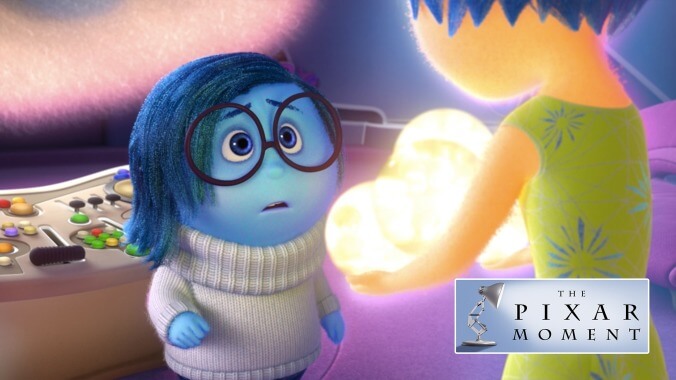Inside Out makes the profound case that sadness is good
Image: Screenshot: Inside Out
Pixar makes its movies for children. Not exclusively for children, of course—Hollywood figured out long ago that it’s more profitable to entertain everyone, rather than have parents fight off intense boredom every time they lug their pre-adolescent kids to the multiplex. (Especially since little kids love watching the same movie over and over and over again, until the words “Hakuna Matata” inspire homicidal thoughts.) Pixar’s films, in particular, tend to be remarkably sophisticated, tackling ideas and emotions that only an adult could possibly process or appreciate. Nonetheless, “must not scar or alienate pipsqueaks” is a constraint influencing every choice the company makes, which is why an uplifting message (often asserting the value of being a little bit different) virtually always gets imparted in the closing minutes. Even when a Pixar movie makes you cry—and they’re by no means bashful about jerking viewers’ tear ducts—the sadness generally arrives at the beginning, or somewhere in the middle. It’s not the point.
Except that it is the point of Inside Out, a tale about anthropomorphized emotions in which Sadness (voiced by The Office’s Phyllis Smith) is not just a character but ultimately revealed to be the film’s most important character. To call it a twist ending might be pushing things a little far, but there’s an unexpected force to Inside Out’s climactic sequence, in which the manic Joy (Amy Poehler) has to accept that human beings aren’t necessarily optimized by her own omnipresence—that being sad has a purpose, as opposed to merely getting in happiness’ way. That’s a truly revolutionary notion for a movie aimed at (or at least determined not to scare off) small children. What’s more, it’s not even a tiny bit subtextual. The Toy Story franchise can be a superficially fun ride even if the stuff about obsolescence flies over your head, but needing to embrace sadness (Sadness) is Inside Out’s surface-level narrative, ensuring that it can’t be missed, ignored, or rationalized away. The movie literally does not make sense unless you reckon with it.
That said, there is a visual metaphor at work. After Joy finally realizes that Sadness has a function and isn’t just a whiny annoyance, she brings her back to the mental control room of their person, an 11-year-old girl named Riley who’s currently in the process of running away from home. Riley’s memories, we’ve learned by this point, are stored as small orbs, each one sporting the color of its dominant emotion: yellow for happy memories, blue for sad ones, red for angry ones, etc. No orb has more than one color. It’s the creation of Riley’s first mixed emotion that pulls her out of her downward spiral. Joy, who’s spent the entire movie zealously guarding the yellow orbs from Sadness’ ostensibly infectious touch, hands her colleague several of Riley’s happiest memories and watches them turn blue, now tinged with an awareness that the time they represent is gone and won’t be coming back. Then Sadness feeds them back into the machine, where they re-emerge as memories that are now designated as happy and sad. (Significantly, they retain swirls of both yellow and blue, separately, rather than simply merging into a uniform green. Though that’s at least partially because green already serves as Disgust’s color.)
Let’s state that again, more plainly: Inside Out’s happy ending—and it is very much a happy ending—involves making a little girl cry by adding a sense of regret to the happiest moments of her young life. Try to imagine the meeting in which that idea got pitched to a bunch of suits responsible for ensuring that Pixar’s stockholders won’t see their memories of buying shares turn from yellow to blue. Director Pete Docter and his co-screenwriters, Meg LeFauve and Josh Cooley, reportedly consulted various experts in an effort to ensure that their concept was psychologically sound, but that didn’t make it any less risky as the basis for a $175 million animated feature that absolutely must have widespread kiddy appeal. Pixar trusts its creative team, though, even when they insist that they can fashion a crowdpleaser from the inception of bittersweetness. Mission resoundingly accomplished, and anyone who can watch Sadness reconfigure Riley’s entire early childhood without tearing up themselves should feel… which color is mortification?